In the fall months after harvesting, cherry trees and shrubs are pruned. Removing extra branches is carried out after the end of sap flow, the final establishment of cold weather.
Timely, correctly conducted procedure helps to fully reveal the potential of the plant, improves fruiting. In a haircut of cherries of different ages and types, there are some nuances.
Content
The need for autumn pruning
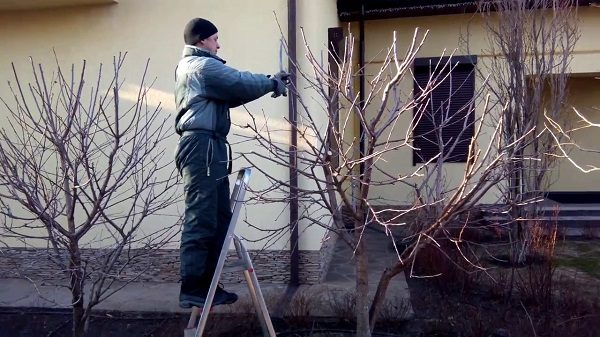 To improve fruit trees and shrubs, it is important to remove old, diseased shoots in time in the fall. This procedure is of great benefit to the plant:
To improve fruit trees and shrubs, it is important to remove old, diseased shoots in time in the fall. This procedure is of great benefit to the plant:
- forms the crown of the tree correctly;
- rejuvenates the plant;
- prevents or eliminates excessive thickening of the crown;
- lays the potential for increasing yields.
For haircuts, two methods are used. When thinning, the branches are cut off completely to the full length. Shortening involves cutting off only part of the shoot. Both methods are practiced in the cultivation of fruit crops, including for cherries and plums.
When to trim
All work on removing unnecessary branches is completed before the first frost. In regions with a cold climate, in Siberia or the Urals, lowering of air temperature begins in October. Therefore, the haircut is completed at the end of September. Where the climate is milder, these works are carried out later, at the end of November.
Necessary tools for work
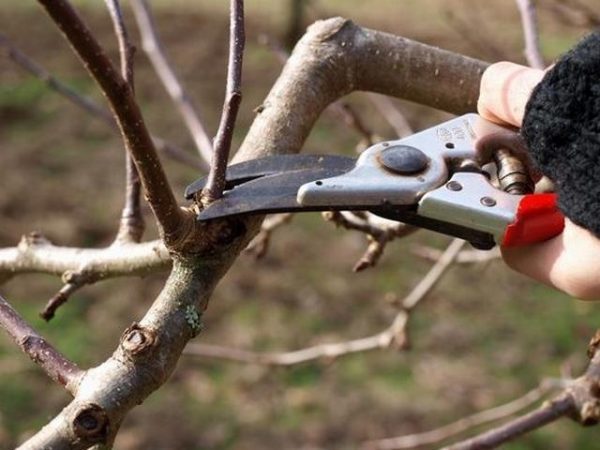 Although pruning cherries in autumn is not a difficult job, it requires attention and some effort from the gardener. In order not to damage the cherry, choose quality tools from trusted manufacturers with a good reputation. For the rehabilitation will require:
Although pruning cherries in autumn is not a difficult job, it requires attention and some effort from the gardener. In order not to damage the cherry, choose quality tools from trusted manufacturers with a good reputation. For the rehabilitation will require:
- Secateurs - the main tool for the job. They remove shoots from young plants or branches of small thickness.
- A hacksaw or garden saw is used to cut fear of branches whose thickness exceeds 50 mm.
- The delimber is used while working in an inaccessible place of the crown.
Only sharpened tools are suitable for work. With them, the gardener has to make less effort. They are safe, do not damage the plant so much. It is desirable that anti-slip rubber pads are provided on the tool handle. To protect hands before work wear special gloves.
 You may be interested in:
You may be interested in:Important points for autumn pruning
When thinning the crown of cherry, it is important to consider its appearance. The formation of tree and bush varieties is carried out according to different schemes. In the first case, the length of the annual shoots is reduced. This encourages the plant to form lateral branches on which the berries grow. For bushy cherries, annual growths are not cut, as this leads to the drying of the entire branch.
After several years of development, tree cherry growth is limited. Further processing is to prevent weaving of branches, to prevent the growth of shoots inside the crown or down.For strongly thickening bush-like species, all large branches are removed during cultivation, thinning out the plant more thoroughly.
Pruning plants of different ages
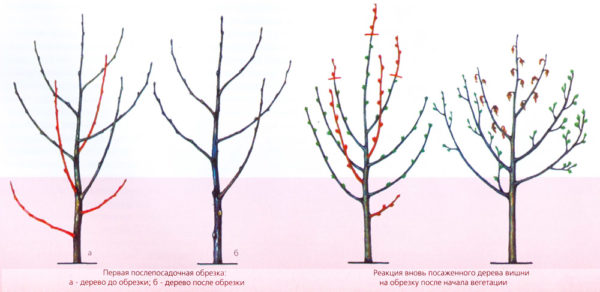 Differences in the processing of individual trees and cherry bushes depend not only on the species or variety. There are nuances in the rehabilitation of cherries, depending on the yield and age of the plant. Let's consider each method in more detail.
Differences in the processing of individual trees and cherry bushes depend not only on the species or variety. There are nuances in the rehabilitation of cherries, depending on the yield and age of the plant. Let's consider each method in more detail.
Autumn pruning for young trees
For young trees, the main task of the gardener during the autumn haircut is the correct formation of the crown. Such plants are rarely susceptible to disease and less damaged by pests, so they do not need to remove diseased or dry branches. Another purpose of cultivation is the prevention of excessive crown density. In this case, it is important not to touch the branches of the skeletal base of the tree.
The initial removal of branches for young cherries is carried out immediately after landing. In this case, only 5 or 6 of the strongest are left, and the rest are cut off. To accelerate the healing of wounds, the places of cuts on a tree are covered with oil paint or garden varnish. In order for the crown of cherry to form further spreading, leave branches growing in different directions.
Features pruning for fruiting plants
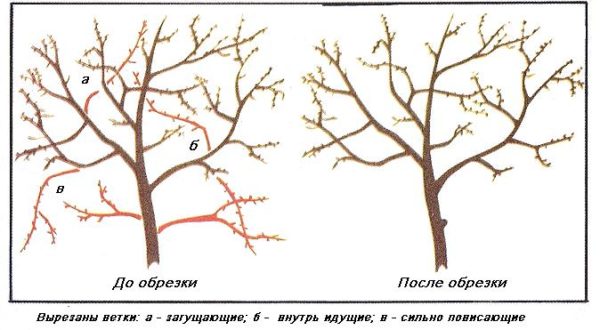 Unlike other fruit crops, cherries begin to produce crops quite early. This is both its positive and negative quality. High yields are good for the gardener, but earlier fruiting depletes the tree and it grows older faster. Therefore, fruiting shoots are also cultivated from time to time.
Unlike other fruit crops, cherries begin to produce crops quite early. This is both its positive and negative quality. High yields are good for the gardener, but earlier fruiting depletes the tree and it grows older faster. Therefore, fruiting shoots are also cultivated from time to time.
With regular shearing, the tree is less depleted. The remaining branches, even with a small amount, give a rich harvest. The berries in this case grow larger and juicier.
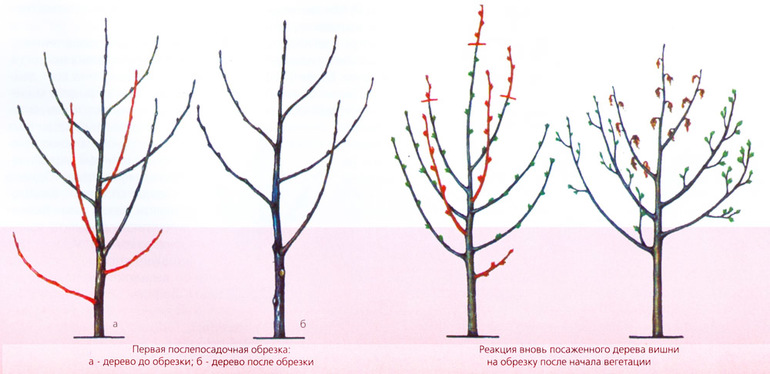 You may be interested in:
You may be interested in:Reforestation of old trees
The main task for beginners in the cultivation of old copies of cherries is the removal of dried and diseased shoots that prevent the young branches from developing. This event is a must, it helps to prevent the development of diseases and prolongs the life of the plant.
It is best to prune the old tree in the spring, when the weather is already warm enough and the probability of frost is minimal. At this time, pruning is perceived by the plant more easily. In addition to damaged shoots, branches that are directed downward or strongly curved are removed during rehabilitation.
Sanitation of cherries of various shapes
Autumn pruning of cherries and cherries is also different from the type of plant. The removal of branches in the tree and bush species is carried out in different ways.
Remediation of felt grades
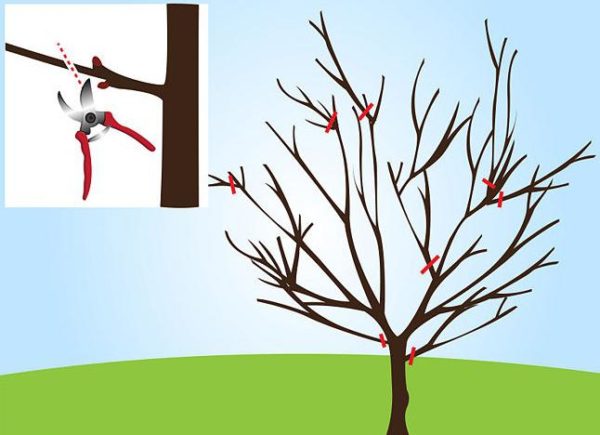 This type of cherry is pleasant to gardeners for the decorativeness of bushes, earlier fruiting and the absence of thickening of the crown overgrown. Therefore, in the fall, a bush of felt cherry is much easier to trim. At the same time, autumn sanitation is a very important event for the care of the plant. The life span of felt grades is very short and is no more than 10 years, but with the right pruning it doubles.
This type of cherry is pleasant to gardeners for the decorativeness of bushes, earlier fruiting and the absence of thickening of the crown overgrown. Therefore, in the fall, a bush of felt cherry is much easier to trim. At the same time, autumn sanitation is a very important event for the care of the plant. The life span of felt grades is very short and is no more than 10 years, but with the right pruning it doubles.
Since the fruiting of felt varieties is usually carried out on annual shoots, they are not touched when they are trimmed. Only strongly elongated branches longer than 50 cm are shortened by a third of the length.
Remediation for this variety of cherries is performed by removing all broken or diseased processes. With anti-aging pruning, the selected side shoots on the ring are removed. In this case, do not touch the central part of the crown and skeletal branches. First, they are shortened and the appearance of young lateral shoots from sleeping buds is awaited.Only then do they cut out the old crown.
Bush Cherry Pruning
Cultivation of the bush variety is performed by cutting branches completely without stumps. Otherwise, intense gumming begins. This slows down the restoration of the plant after rehabilitation, and diseases and insects easily penetrate into unhealed wounds.
Branch removal is performed if the plant grows less than 20 cm per year. To begin with, reorganization is carried out and shoots broken and damaged by diseases are cut. Then proceed to cutting branches that do not branch. The remaining branches are cut length, shortening them to the first strong branching.
Tree Cherry Pruning
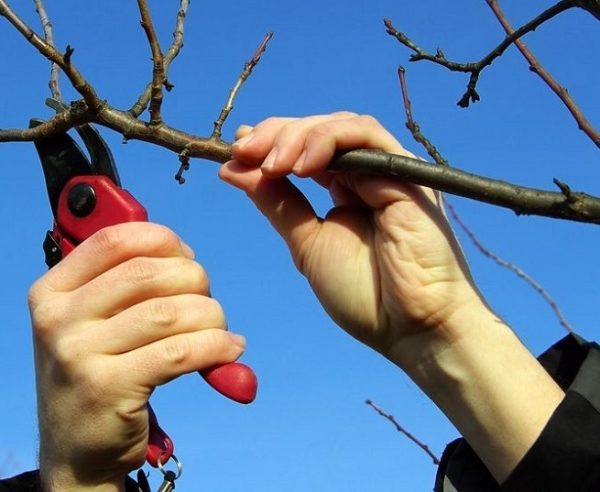 In contrast to the artisanal variety, when the berries appear on annual shoots and flower branches, in a cherry tree, the crop ripens only at the growth of one year. In this case, cutting branches is thought out in advance. You cannot delete all shoots in a row. Reducing the length of the branches of the crown is carried out gradually and does not touch the shoots with a length of less than 2-3 m.
In contrast to the artisanal variety, when the berries appear on annual shoots and flower branches, in a cherry tree, the crop ripens only at the growth of one year. In this case, cutting branches is thought out in advance. You cannot delete all shoots in a row. Reducing the length of the branches of the crown is carried out gradually and does not touch the shoots with a length of less than 2-3 m.
If the growth of the tree becomes less intense, cut branches that do not give young shoots. With rapid growth, thinning cultivation is carried out. All old branches are removed for the purpose of rejuvenation only when the annual growth does not exceed 15 cm. In this case, cross-growing shoots are necessarily cut.
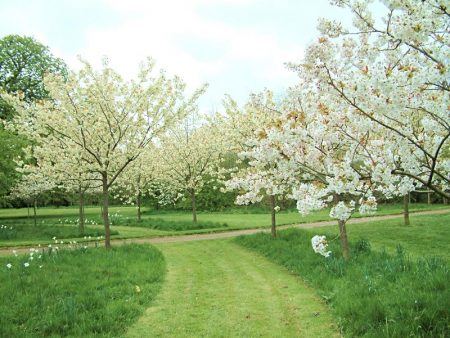 You may be interested in:
You may be interested in:Care after trimming
Having completed all activities to remove branches, the remaining garbage in the near-trunk circle is raked and destroyed. This helps prevent the spread of harmful insects and diseases. In addition, among the mandatory winter care and preparation activities includes:
- Fertilization using mineral complexes or organics. For this, fertilizers with a high content of phosphorus and potassium are used.
- Watering is combined with fertilizer application. Cherry is irrigated abundantly. Before this, the periostemal circle is dug up to half a bayonet of a shovel.
- Prevention of diseases and pest infections is carried out with a urea solution of 5% concentration. Spraying is performed after the onset of the first frost.
- Shelter for the winter is not required for cherries, as this crop has good winter hardiness. In severe winters with very severe frosts, they cover the near-trunk circle with straw, and then periodically throw snow. This will protect the root system of the plant from freezing.
Some tips
In the absence of experience, many gardeners make mistakes by performing an autumn haircut of cherries. But this event is necessary to constantly get a big harvest. Besides pruning trees in autumn contributes to a successful wintering of the plant.
Answering the question of how to cut the cherry in the fall so that there is a good harvest, experienced gardeners recommend following the following tips for beginners:
- Correctly cut the cherry before the onset of frost.
- Unlike other fruit plants, buds on a cherry tree are located at the ends of branches, and not along the entire length. Therefore, during the haircut, they are completely removed or simply thinned out, leaving 2-3 pieces on each shoot. This method maintains a high yield.
- Complete rejuvenation of cherries is convenient to perform with a saw.
- The tree is trimmed, trying to give all annual branches a length of 30 cm. With this method, there will be no bare branches.
- Root shoots are harvested annually, as it significantly reduces yield.
- For a cherry tree, the optimal height is 3 m. Therefore, as soon as the tree reaches this point, the top is cut.
- Crohn in this culture quickly overgrows. Therefore, trimming work is carried out annually. Otherwise, the growth of fruiting shoots is suspended.
- All in a row branches on a cherry are not deleted. Be sure to leave annual shoots and bouquet branches.
Until now, the opinions of experts on when it is better to cut the cherries in spring or autumn differ. But long-term observations have shown that autumn cutting of the plant is much more beneficial. It also helps to better survive the winter cold. The purpose of autumn cultivation is not a complete change in the appearance of a tree or bush, but a correction of the shape of the crown and sanitary cleansing. It is necessary to improve productivity and prevent various diseases.

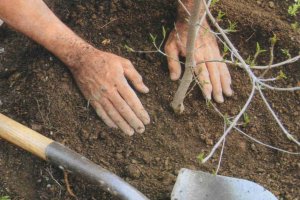 Autumn cherry transplant - important points step by step
Autumn cherry transplant - important points step by step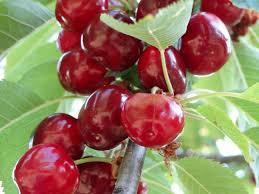 All about the Turgenevskaya cherry variety
All about the Turgenevskaya cherry variety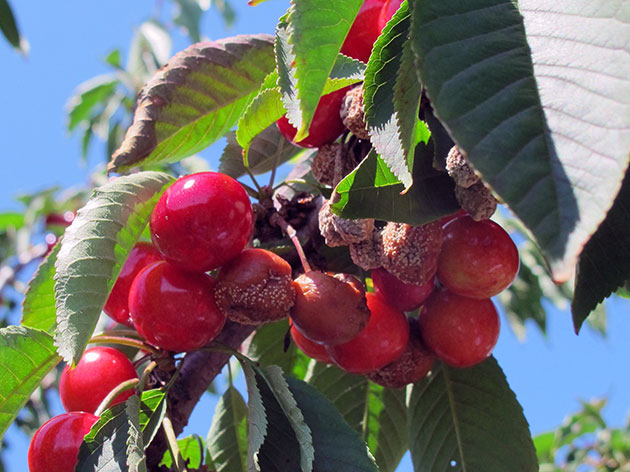 Cherry Disease: Description with Photos
Cherry Disease: Description with Photos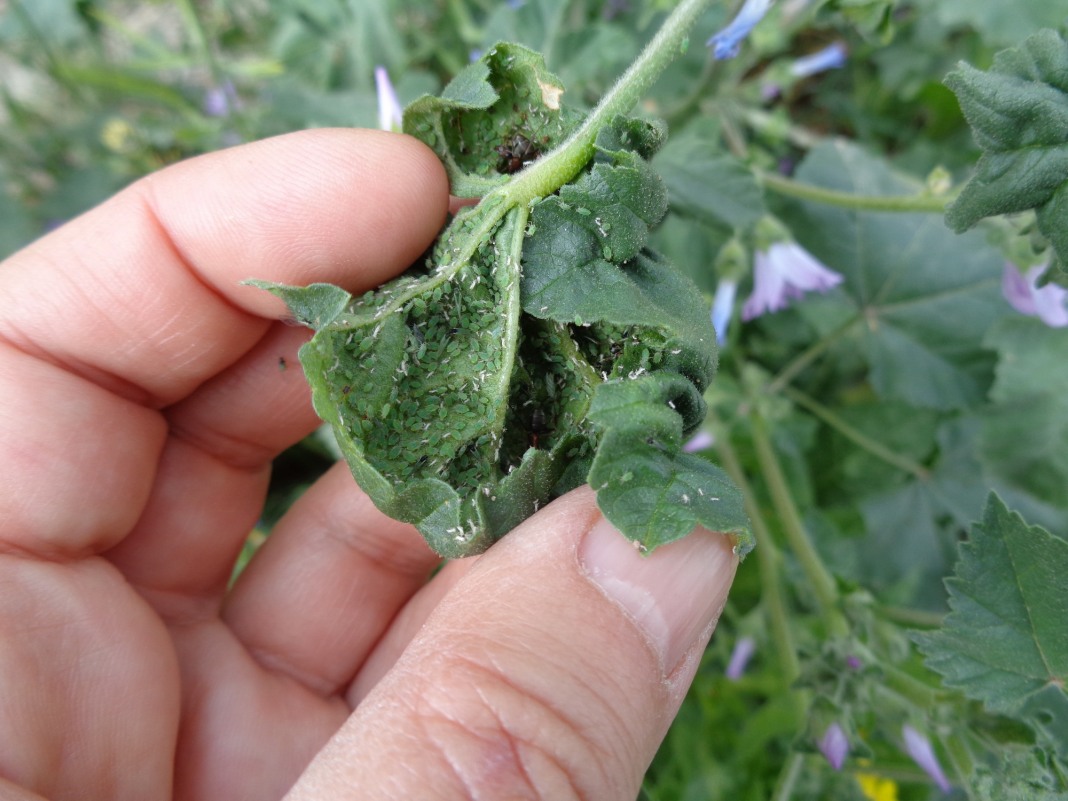 Ways to get rid of aphids on a cherry
Ways to get rid of aphids on a cherry